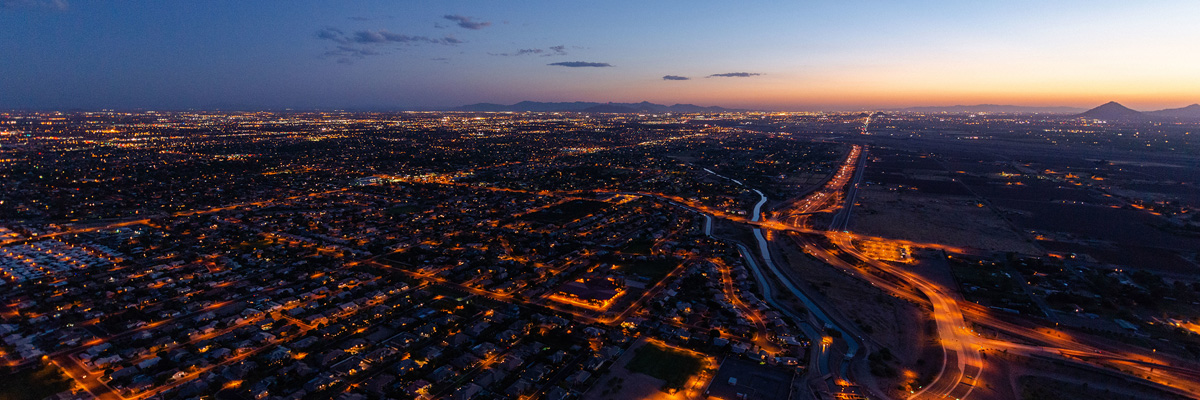
Southeast Power Link FAQ
See how new infrastructure will enhance electric system reliability and enable community growth in the Southeast Valley.
On this page:
Frequently asked questions and answers
About the project
The Southeast Power Link project is a public process to site new 230-kilovolt (kV) electric transmission lines in a region that includes the Elliot Road Technology Corridor and other areas generally to the east of Phoenix-Mesa Gateway Airport. SRP is planning these additions to the power system in order to provide reliable and affordable electric service to current and future customers in this rapidly growing region.
Project components:
- We are proposing approximately 7 miles of new overhead, double-circuit, 230 kV power lines.
- The plan also includes a 230 kV receiving station.
See map and project details for more information.
SRP has sufficient electrical facilities in place to meet the current needs of the region. However, as future economic expansion occurs, new SRP facilities will be necessary to meet the forecasted increase in energy demand.
No, SRP is a community-based, not-for-profit organization. We make decisions in the best interest of our customers and the communities we serve. We do not have shareholders or pay dividends. Revenues generated through the sale of electricity are reinvested in the company to help keep SRP prices among the lowest in the Southwest.
Project need and benefit
Energy needs are growing in the Southeast Valley as commercial, industrial and residential growth continues in this region. To provide highly reliable electric service to current and future customers, SRP is looking ahead and planning additions to the power system.
By starting now, SRP can enable the growth envisioned in local economic development plans while maintaining reliable and cost-effective electric service for existing customers in the region. SRP can also coordinate transmission line siting activities with other infrastructure projects planned for the region such as airport expansion and new SR24 freeway construction.
SRP is planning these additions to the power system in order to provide reliable and affordable electric service to current and future customers in this rapidly growing region.
In addition, with the project in service SRP can support the growth envisioned in local economic development plans. Benefits that often accompany economic development include:
- New businesses which generate jobs.
- Increased demand for homes.
- A growing tax base that supports the community.
Public process
SRP conducted a robust public process which included extensive outreach activities. The process included 40 meetings with municipalities, agencies, landowners and other stakeholders. In addition, SRP held a public open house on May 14, 2018, to solicit input on potential route options from local residents and businesses.
Based on this feedback, SRP filed an application for a Certificate of Environmental Compatibility (CEC) with the Arizona Corporation Commission (ACC) on Aug. 1, 2018, for the proposed project.
On Nov. 7, 2018, the ACC unanimously approved the CEC for the project. The approval is the final step of the application process and enables SRP to move forward with land acquisition, project design and construction.
Based on public need and the comments gathered throughout the public involvement process, including an in-person open house, SRP will present potential locations for power lines and the receiving station in its application for a Certificate of Environmental Compatibility (CEC) submitted to the Arizona Power Plant and Transmission Line Siting Committee.
The Line Siting Committee then makes a recommendation regarding the project to the Arizona Corporation Commission (ACC) for its consideration. The ACC then issues a final decision whether to approve, modify or deny the CEC application for the project.
Line design and engineering
SRP estimates that the project will require approximately 7 miles of new overhead, double-circuit, 230 kV transmission lines. Generally, overhead SRP 230 kV lines in suburban settings are 100-150 feet tall with distances between poles in the range of 500 to 1,000 feet. See sample photos.
However, significant Federal Aviation Administration (FAA) height restrictions exist near the Phoenix-Mesa Gateway Airport. To meet current FAA height restrictions, pole heights along portions of SR24 and Crismon Road would need to be as low as approximately 65 feet, possibly with two parallel sets of poles, and the distance between poles could potentially be as little as 150 feet.
SRP is in the process of validating alternative designs that can meet current FAA height restrictions. SRP has also submitted an application to the FAA to construct standard poles in this area. The FAA has a process to evaluate new construction projects near airports, and may be able to accommodate more typical transmission line construction techniques.
SRP's construction standard for 230 kV power lines is to build them overhead, given the significant additional cost of underground construction, and in fairness to all of our customers. The cost of underground construction is approximately 10-20 times higher than overhead at this voltage.
SRP can place lines underground in certain circumstances, however, the additional cost would need to be absorbed by the entity requesting the undergrounding.
SRP recognizes that some customers have concerns about whether exposure to EMF may contribute to human health problems. Therefore, SRP provides this summary of available information regarding EMF research, exposure levels, and guidelines.
Property questions
Soon after SRP receives a CEC for the line, we will design the line within the certified corridor. If an easement is needed, SRP will hire an independent appraiser to value your property and the easement. You, as the property owner, will receive a copy of the appraisal report with an offer letter from SRP to purchase the easement.